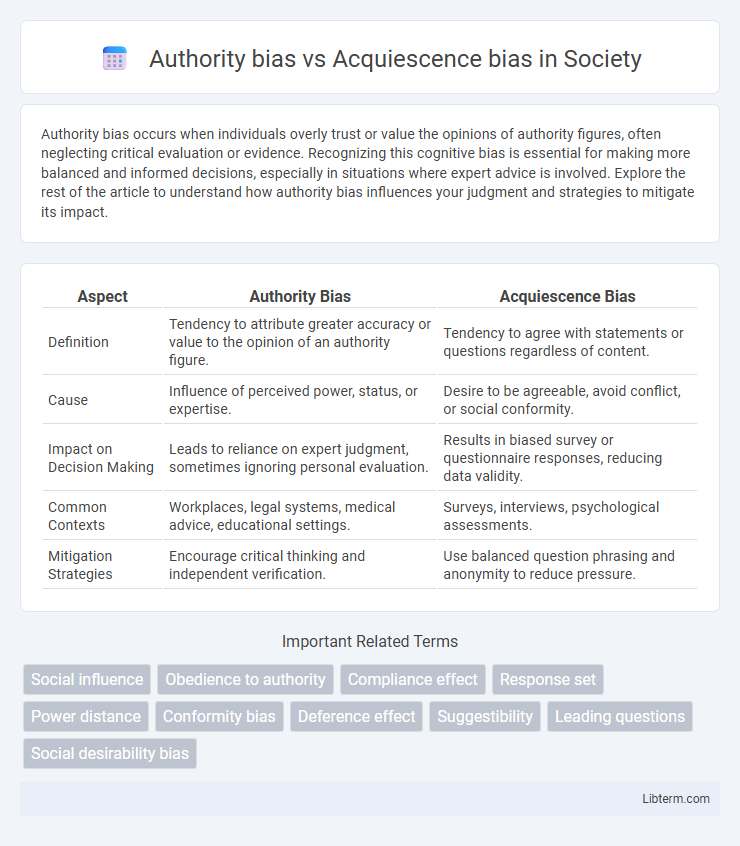Authority bias occurs when individuals overly trust or value the opinions of authority figures, often neglecting critical evaluation or evidence. Recognizing this cognitive bias is essential for making more balanced and informed decisions, especially in situations where expert advice is involved. Explore the rest of the article to understand how authority bias influences your judgment and strategies to mitigate its impact.
Table of Comparison
| Aspect | Authority Bias | Acquiescence Bias |
|---|---|---|
| Definition | Tendency to attribute greater accuracy or value to the opinion of an authority figure. | Tendency to agree with statements or questions regardless of content. |
| Cause | Influence of perceived power, status, or expertise. | Desire to be agreeable, avoid conflict, or social conformity. |
| Impact on Decision Making | Leads to reliance on expert judgment, sometimes ignoring personal evaluation. | Results in biased survey or questionnaire responses, reducing data validity. |
| Common Contexts | Workplaces, legal systems, medical advice, educational settings. | Surveys, interviews, psychological assessments. |
| Mitigation Strategies | Encourage critical thinking and independent verification. | Use balanced question phrasing and anonymity to reduce pressure. |
Understanding Authority Bias
Authority bias occurs when individuals disproportionately value opinions or instructions from perceived authority figures, often leading to uncritical acceptance of their statements. This cognitive bias can distort judgment by prioritizing authority over evidence, increasing the likelihood of compliance even when the authority's directives may be flawed or inaccurate. Recognizing authority bias is crucial for fostering independent critical thinking and mitigating undue influence in decision-making processes.
Defining Acquiescence Bias
Acquiescence bias is the tendency of respondents to agree with statements or questions regardless of their content, often skewing survey results. This bias differs from authority bias, which involves valuing information or opinions from perceived authority figures disproportionately. Understanding acquiescence bias is crucial for designing surveys that minimize agreement bias through balanced question phrasing and validation techniques.
Key Differences Between Authority and Acquiescence Bias
Authority bias occurs when individuals disproportionately trust or follow directives from perceived authority figures, leading to skewed judgments based on the source rather than content. Acquiescence bias involves a tendency to agree with statements or questions regardless of their content, often driven by a desire to please or avoid conflict. The key difference lies in authority bias being influenced by the status of the influencer, while acquiescence bias is rooted in a respondent's general compliance or agreeableness.
Causes of Authority Bias
Authority bias arises from the human tendency to attribute greater accuracy and trustworthiness to information presented by perceived experts or authority figures, often due to social conditioning and respect for hierarchical structures. This bias is fueled by cognitive shortcuts that simplify decision-making, leading individuals to accept statements from authorities without critical evaluation. Evolutionary psychology also suggests that following authority figures enhanced group survival, reinforcing the predisposition to adhere to authoritative opinions.
Origins of Acquiescence Bias
Acquiescence bias originates from individuals' tendency to agree with statements or questions regardless of their content, often driven by social desirability or a desire to conform to perceived authority. This bias is rooted in psychological mechanisms such as the need for social approval and avoidance of conflict, influencing respondents to provide affirmative responses. Unlike authority bias, which involves deference specifically to perceived experts, acquiescence bias broadly reflects a generalized inclination to agree, affecting survey validity and response accuracy.
Real-World Examples of Authority Bias
Authority bias occurs when individuals attribute greater accuracy or truth to statements made by authority figures, often leading to skewed decision-making in fields such as healthcare, legal systems, and marketing. A famous real-world example includes the Milgram obedience experiments, where participants complied with authority instructions to administer what they believed were harmful electric shocks, demonstrating how perceived authority can override personal ethics. In contrast, acquiescence bias involves a tendency to agree with statements regardless of content, often influencing survey responses rather than hierarchical obedience.
Real-World Examples of Acquiescence Bias
Acquiescence bias frequently appears in survey research when respondents tend to agree with statements regardless of content, as seen in studies where participants consent to dubious claims simply to please the interviewer. This bias has been documented in employee satisfaction surveys, where workers often provide overly positive feedback fearing repercussions, skewing organizational assessments. Real-world examples also include market research, where consumers habitually affirm products or services, leading companies to misinterpret demand and customer satisfaction levels.
Impacts on Decision-Making and Research
Authority bias leads individuals to overly trust experts or figures of authority, potentially skewing decision-making by limiting critical evaluation of information; this can result in adherence to flawed recommendations despite contradictory evidence. Acquiescence bias causes respondents to agree with statements regardless of content, compromising the validity of research data by inflating positive responses and masking true opinions or behaviors. Both biases distort outcomes, undermine the integrity of data collection, and hinder effective problem-solving in organizational and academic contexts.
Strategies to Minimize These Biases
Implementing anonymous surveys and encouraging independent critical thinking help minimize authority bias by reducing undue influence from perceived experts. Employing balanced question phrasing and randomized response options counteracts acquiescence bias, preventing automatic agreement patterns. Training participants to recognize these biases enhances awareness and promotes more accurate, unbiased responses in research and decision-making contexts.
Authority Bias Versus Acquiescence Bias: A Comparative Analysis
Authority bias occurs when individuals disproportionately attribute credibility to information from perceived experts, influencing judgment and decision-making, whereas acquiescence bias involves a tendency to agree with statements regardless of content, often skewing survey or research responses. Both biases distort objective evaluation but differ in their cognitive triggers: authority bias hinges on source credibility, while acquiescence bias stems from social conformity or cognitive ease. Understanding these distinctions is crucial for designing reliable research methodologies and improving critical thinking in information processing.
Authority bias Infographic

 libterm.com
libterm.com